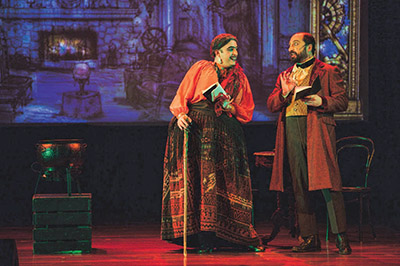



Once again, the National Yiddish Theater Folksbiene (NYTF) delighted New York audiences with its brief but dazzling production of “The Sorceress,” which was performed from December 25 through January 1 at The Museum of Jewish Heritage in Battery Park.
Exuberant, energetic and most entertaining, the production is yet one more work inspired by the restoration of scores and librettos of Yiddish operettas, musicals and plays that were on the verge of being lost forever. After World War II, the YIVO collection in New York received a trove of Yiddish theater manuscripts that had been hidden behind walls, in milk cans and in church basements in order to keep them out of the hands of the Nazis, who were preparing to donate them to their nefarious Museum of an Extinct Race. Among the salvaged documents were crumbling and water-logged librettos and scores from many famous Yiddish productions including “The Sorceress,” which had been produced in Kiev and Odessa at the beginning of the 20th century. Through the fastidious and painstaking restorative work of the Folksbiene’s artistic director for the past 18 years, Teaneck’s Zalman Mlotek, “The Sorceress,” the 2015 hit “The Golden Bride” and many other Yiddish classics have been saved from oblivion to be enjoyed by generations of theatergoers internationally.
“The Sorceress” is one of the earliest works by famous Yiddish playwright Avrom Goldfaden who penned the play in 1828. Goldfaden’s vision was to elevate Yiddish productions from the level of amateur wandering productions acted by “shpielers” to serious works of dramatic art. “The Sorceress” rose to success within a short span of time and toured major cities in Europe as well as small shtetls.
The story is told that in 1882, 14-year-old Boris Thomashevsky, later to become one of Yiddish theater’s most acclaimed actors, had recently emigrated to the US. Always dreaming of opening a Yiddish theater in America, Thomashevsky was entranced by the tunes his co-workers at the cigarette factory would hum from the now-famous Yiddish play “The Sorceress,” which had been performing in London. He cleverly managed to convince a Bowery beer hall owner to finance his bringing the troupe over from England. It is debated whether, at the tender age of 14, Thomashevsy directed the play’s American debut or acted in the main role. In either case, he and the play became a wild success.
The play, which borrows many tunes from Viennese operettas, takes its theme from Goldfaden’s native Romanian folklore in which fortune tellers played prominent roles in solving daily dilemmas. Goldfaden was attempting, through his play, to distance uneducated Jews from their belief in magic, including the amulets, potions and spells used by the Roma, local gypsies, to entrap the local population.
The NYTF production of “The Sorceress” is played against a backdrop of sparse scenery and only a simple electronic screen that changes from scene to scene. Some of the actors actually read their parts directly from scripts, which they hold in their hands. This script-in-hand staged reading is the result of a mere five days of rehearsal. Yet to the audience, the production is as riveting as if it were a Broadway extravaganza. The 17 actors are accompanied by a live 10-piece orchestra, including Mlotek on keyboard, and Motl Didner, director and NYTF associate artisitc director, who works alongside Mlotek in restoring the Yiddish scores and librettos.
As to the story line, an evil Basye, recently married to a widower Elyokem, is trying to arrange his and his 17-year-old daughter’s deaths so that she can inherit their fortune. She utilizes the sevices of Bobe Yakhne, the evil sorceress modeled on the wicked mythical Slavic witch Bobe Yaga. Traditionally, as well as in this production, the witch is played by a male actor. The sorceress shares with her audience that “her magic consists in exploiting the superstitious beliefs of others in order to outsmart and profit by them.” Through this character, Golfaden wanted to convey to his Jewish audiences that rationality should be substituted for primitive folk belief. Through a series of fortunate interventions, the play ends on a happy note. A witty and mischievous peddlar named Hotsmakh provides hilarious comic relief throughout the play.
In its continuing mission to delight audiences with the treasures of Yiddish theater worldwide, the National Yiddish Theater Folksbiene has announced that the summer of 2018 will mark the debut of a new Yiddish production of the acclaimed “Fiddler on the Roof.” Tickets go on sale on February 1. Visit NYTF.org or call 212-213-2120 ext.206 for information and advanced sales.
Upcoming winter performances include “Soul to Soul” on Monday, January 15, Martin Luther King Jr. Day, when Yiddish and African-American music will meet in a celebration of two cultures. On Sunday, February 11, NYTF will present “”Early Yiddish Theater & Vaudeville Concert,” an exclusive concert of rediscovered and revitalized work from vaudeville and the early years of Yiddish theater. For tickets, visit NYTF.org
By Pearl Markovitz










